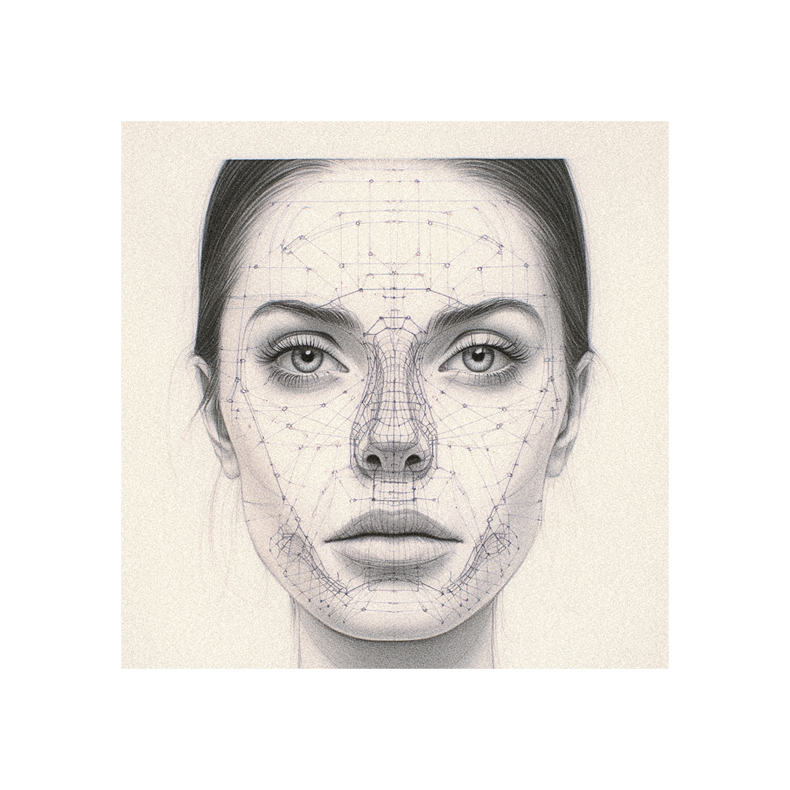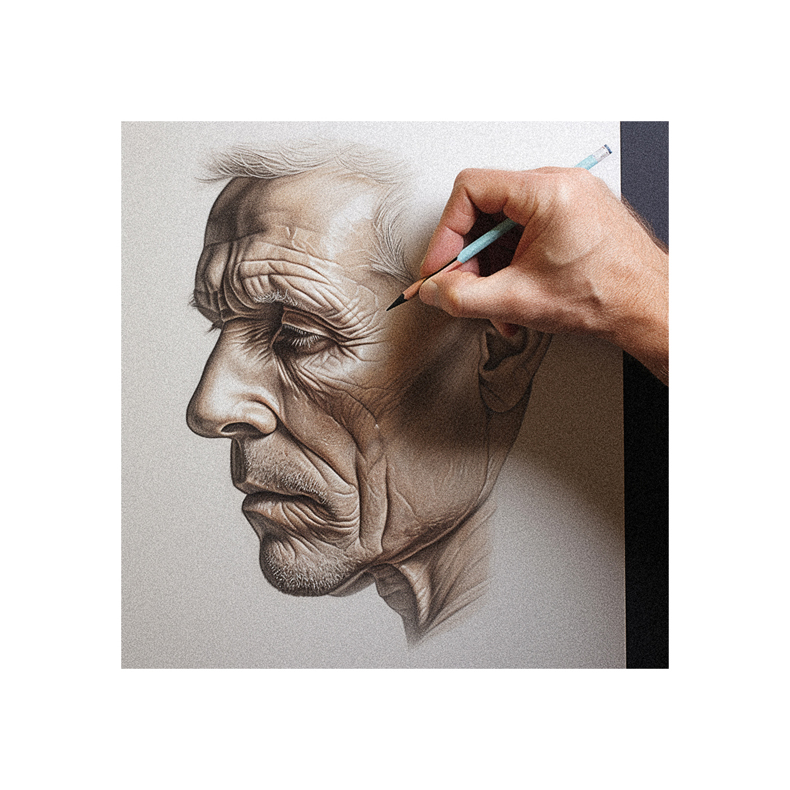Ready to take your portrait art to the next level? In the world of facial anatomy techniques, understanding the intricacies of the human face is paramount for creating realistic and accurate portraits. From capturing the delicate curves of a nose to portraying eyes with depth and dimension, mastering these techniques will elevate your artwork.
This article delves into the essential aspects of facial anatomy that every portrait artist should know. You’ll discover how to identify major facial bones and landmarks, allowing you to depict structure and proportions accurately. We also explore the significance of hair as a crucial element in portraiture and techniques for drawing foreshortened heads.
But that’s not all – we’ll guide you through building eye sockets that capture different angles and perspectives, bringing life to your subjects’ gaze. Additionally, we’ll delve into the intricate details of lips, wrinkles, and even ears – those often overlooked but crucial features.
With step-by-step instructions and valuable insights on blending, shading, and adding highlights for realism, this article will equip you with the knowledge needed to create captivating portraits that truly come alive on canvas or paper.
So grab your pencils or brushes because it’s time to embark on an artistic journey into facial anatomy techniques!
What is it?

Now, let’s dive into facial anatomy techniques and how they can benefit you as a portrait artist. Facial anatomy techniques refer to the study and understanding of the structure and proportions of the face. You can create more accurate and realistic portraits by learning about the bones, muscles, and features that make up the face.
These techniques help you capture the unique characteristics of each individual’s face, including facial expressions, bone structure, and even details like wrinkles and dimples. Understanding facial anatomy allows you to accurately depict different angles and perspectives of the face, ensuring that your portraits look lifelike and believable.
Incorporating these techniques into your artwork can enhance your skills as a portrait artist and create stunningly realistic portrayals of people’s faces.
Structure and Landmarks

Start by exploring the structure and landmarks of the face, like a skilled cartographer mapping out the contours of a new land. Understanding the underlying framework is crucial for creating realistic portraits.
Here are three key elements to focus on:
- Skull Structure: Begin with the foundation of the head, noting major bony landmarks such as the brow ridge, cheekbones, and jawline. These structures provide a solid base for drawing facial features accurately.
- Eye Socket: Before tackling the intricate details of the eye itself, identify the shape and depth of the eye socket. This will help you position and shape the eyes correctly within their surroundings.
- Ear Placement: The ear is an excellent landmark for locating other parts of the face. Use it as a guide to determine the proper positioning of features like the nose, mouth, and jawline.
By mastering these structural elements and landmarks, you’ll be equipped to create lifelike portraits that capture both likeness and character.
Major Facial Bones

The underlying framework of the face is like a hidden treasure map, with major bony landmarks serving as precious gems that shape and define the features.
One of these important landmarks is the skull, which provides the foundation for the entire face. The skull consists of various frontal, parietal, temporal, and occipital bones. These bones structure the forehead, sides of the head, and back of the head, respectively.
Another significant bone is the maxilla, also known as the upper jawbone. It forms part of the nose and supports the upper teeth.
The mandible, or lower jawbone, plays a crucial role in facial expression and movement.
Finally, we have the zygomatic bones or cheekbones that contour our faces.
Understanding these major facial bones allows portrait artists to depict proportions and capture realistic facial features accurately.
Grouping Facial Bones

Understanding the interconnectedness of the facial bones allows artists to capture the essence and depth of their subjects, breathing life into their portraits. By grouping facial bones, you can create a more convincing and realistic representation of the human face.
Here are three ways in which this technique can evoke emotion in your audience:
- Highlighting the cheekbones: Accentuating the shape and structure of the cheekbones can convey strength, determination, or even vulnerability, depending on how you portray them. The shadows that articulate these bones add dimension and character to your subject’s expression.
- Foreshortening the head: Playing with perspective by foreshortening the head can create a sense of intimacy or intensity in your portrait. It draws attention to specific features like the eyes or mouth, allowing you to convey a particular emotion or mood.
- Emphasizing wrinkles and creases: Wrinkles and creases follow the face form and layer on top of each other. By carefully observing and rendering these details, you can communicate age, wisdom, weariness, or joy in your subject.
Mastering these techniques will enable you to portray a likeness and an emotional connection between your artwork and its viewers.
Hair as an Essential Structure

Using hair’s fluidity and movement, artists breathe life into their creations as each strand dances with vitality, capturing the essence of their subjects. Hair is not simply an accessory to a portrait but an essential structure that adds depth and character to the face.
When drawing facial anatomy, it’s essential to consider how hair interacts with the overall composition. Start by observing the direction and flow of the hair strands, as they can guide your understanding of the underlying bone structure. Treat each lock of hair as a separate entity, paying attention to its shape, volume, and texture.
Remember that hair can frame the face or obscure certain features, so be mindful of how it interacts with other elements in your drawing. By mastering the art of depicting hair, you will elevate your portraits to new heights of realism and expressiveness.
Cheekbones and Shadows

Mastering the art of depicting cheekbones and shadows adds dimension and depth to your portraits, bringing them to life with captivating realism.
Cheekbones can vary in shape, either round or angular, and understanding their structure is crucial for creating accurate facial proportions. By carefully observing the play of light and shadow on the face, you can articulate the contours of the cheekbones, adding a sense of three-dimensionality to your drawings.
Shadows around the cheekbones also contribute to the overall form of the face, helping to create a realistic representation. Additionally, wrinkles and creases around the mouth follow the form of the face and layer on top of each other, providing further opportunities for capturing texture and detail.
Attention to these subtle nuances will significantly enhance your ability as a portrait artist.
Foreshortened Heads

To truly capture the essence of a foreshortened head, you must skillfully navigate the complexities of perspective and depth in your drawings.
Foreshortening occurs when an object or body part appears shorter because it’s angled towards the viewer. When drawing a foreshortened head, it’s important to understand how this distortion affects the facial features. The proportions may appear different, with certain areas appearing larger or smaller than usual.
Pay close attention to the placement and size of the eyes, nose, and mouth as foreshortening can affect them. Additionally, consider how shadows and highlights play a role in creating depth and three-dimensionality in your drawing.
By mastering foreshortening techniques, you can create dynamic and realistic portraits that captivate viewers with their sense of dimensionality.
The Ear as a Landmark
The ear serves as a crucial landmark when drawing the face, helping to establish the placement and proportions of other facial features. By understanding the structure and position of the ear, you can accurately locate the eyes, nose, and mouth on your portrait. Here are three reasons why the ear is an important reference point:
- Location: The ear sits at the same level as the eyebrows and extends down to approximately the base of the nose. This helps you determine where to position these features about each other.
- Proportions: The ear’s width can guide for sizing other facial elements. For example, you can compare the eye’s width to that of the earlobe or use it as a reference for determining lip width.
- Angle: The angle at which the ear is positioned on the head can affect other features’ appearance. Observing whether it tilts forward or backward can help you accurately depict foreshortening and create a more realistic portrayal.
By utilizing this valuable information about ears as landmarks, you’ll be well-equipped to capture accurate facial proportions in your portraits.
Building the Eye Socket

When building the eye socket, understanding its structure and position can significantly enhance the accuracy of your portrait drawings. The eye socket is a crucial landmark that helps determine the placement and shape of the eye.
Start by visualizing the socket as a three-dimensional form with its depth and contours. Use reference points like the brow bone, cheekbone, and nose bridge to locate the socket’s edges. Pay attention to how it curves around the eyeball, creating a recessed area for the eye to sit in.
By accurately depicting these subtle variations in depth and shape, you can bring more realism to your portraits. Remember to observe how light interacts with different surfaces within the eye socket, such as shadows cast by eyelashes or reflections on tear ducts. These details will add depth and dimensionality to your drawings.
Mouth and Wrinkles

Explore the intricate beauty of a mouth as wrinkles dance across its surface, revealing a lifetime of stories and emotions. The mouth is a fascinating feature to draw, with its unique characteristics that differentiate between male and female lips.
When drawing the mouth, it’s important to pay attention to the creases and dimples around it, as they add depth and realism to your portrait. Remember that wrinkles follow the form of the face and layer on top of each other, so be sure to capture their subtle curves and shadows.
Drawing a smile with teeth showing can be challenging, but with careful shading, you can create dimension and bring your drawing to life. Don’t forget to blend skin areas for a smooth and realistic finish.
Keep practicing these techniques to master the art of capturing facial anatomy in your portraits.
Follow us on Pinterest for more tips, tutorials, and artist reviews!





